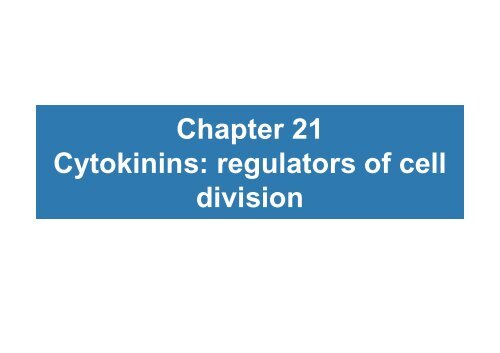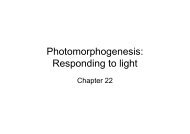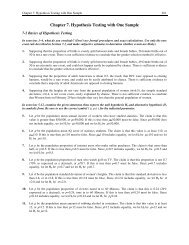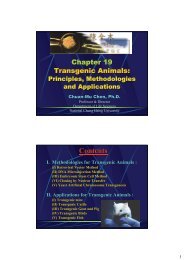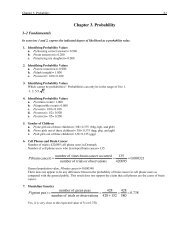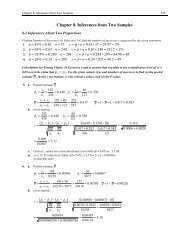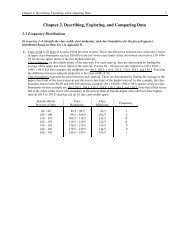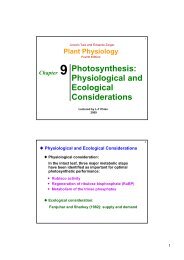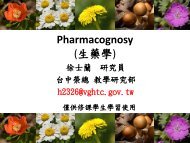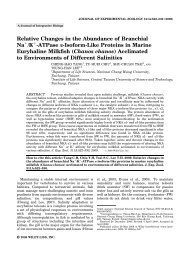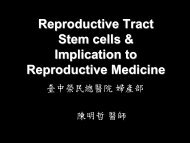Chapter 21 Cytokinins: regulators of cell division
Chapter 21 Cytokinins: regulators of cell division
Chapter 21 Cytokinins: regulators of cell division
Create successful ePaper yourself
Turn your PDF publications into a flip-book with our unique Google optimized e-Paper software.
<strong>Chapter</strong> <strong>21</strong><br />
<strong>Cytokinins</strong>: <strong>regulators</strong> <strong>of</strong> <strong>cell</strong><br />
<strong>division</strong>
Cell <strong>division</strong> and plant development<br />
•Almost every type <strong>of</strong> plant <strong>cell</strong> that retains<br />
its nucleus at maturity has been shown to<br />
be capable <strong>of</strong> dividing<br />
•Differentiated plant <strong>cell</strong>s can resume<br />
<strong>division</strong><br />
-mature <strong>cell</strong>s <strong>of</strong> the cortex and/or phloem<br />
resume <strong>division</strong> to form secondary<br />
meristems<br />
-wounding <strong>of</strong> plant tissues induces <strong>cell</strong><br />
<strong>division</strong> at the wound site, grow as a<br />
mass <strong>of</strong> disorganized, relatively<br />
undifferentiated <strong>cell</strong>s called callus tissue<br />
-when the bacterium Agrobacterium<br />
tumefaciens invades a wound, it can<br />
cause the neoplastc disease called crown<br />
gall
The discovery, identification, and properties<br />
<strong>of</strong> cytokinins<br />
•<strong>Cytokinins</strong><br />
–Stimulate cytokinesis, or <strong>cell</strong> <strong>division</strong><br />
–Eventually coconut milk was shown to contain the cytokinin<br />
zeatin<br />
–The active ingredients in both were modified forms <strong>of</strong><br />
adenine, one <strong>of</strong> the components <strong>of</strong> nucleic acids.<br />
–These growth <strong>regulators</strong> were named cytokinins because<br />
they stimulate cytokinesis.
Zeatin was the first natural cytokinin discovered<br />
•<strong>Cytokinins</strong><br />
–The most common naturally occurring cytokinin is<br />
zeatin, named from the maize (Zea mays) in which it<br />
was found<br />
–Cytokinin can be defined structurally as adenine<br />
derivatives with an isopentenyl-based side chain<br />
attached to the N 6 amino group
Some plant pathogenic bacteria, fungi, insects, and<br />
nematodes secrete free cytokinins<br />
•Crown gall <strong>cell</strong>s have acquired a gene for cytokinin synthesis
Some plant pathogenic bacteria, fungi, insects, and<br />
nematodes secrete free cytokinins
Biosynthesis, Metabolism, and Transport <strong>of</strong><br />
<strong>Cytokinins</strong><br />
•The hormone cytokinin,<br />
GA, and ABA,<br />
carotenoid pigments,<br />
and some plant<br />
defense compounds<br />
known as phytoalexins<br />
are constructed from<br />
isoprene units
Crown gall <strong>cell</strong>s have acquired a gene for<br />
cytokinin synthesis<br />
•The T-DNA gene involved in cytokinin<br />
biosynthesis known as the ipt geneencodes<br />
an isopentenyl transferase (IPT)<br />
enzyme that transfers the isopentenyl<br />
group from 1-hydroxy-2-methyl-2-(E)-<br />
butenyl 4-diphosphate (HMBDP) to<br />
adenosine monophosphate (AMP) to form<br />
tZRMP
IPT catalyzes the first step in cytokinin biosynthesis<br />
•HMBDP for the bacterial<br />
IPT vs. DMAPP for the<br />
plant IPT<br />
•The bacterial enzyme<br />
directly produce a<br />
zeatin-type cytokinin<br />
and plant enzymes<br />
produce the iP-type<br />
•Plant enzymes utilize<br />
ATP/ADP preferentially<br />
over AMP
<strong>Cytokinins</strong> from the root are transported to<br />
shoot via the xylem<br />
•Root apical meristems are a major site <strong>of</strong> synthesis <strong>of</strong> the free<br />
cytokinins in whole plants<br />
•The cytokinins synthesized in roots appear to move through the<br />
xylem into the shoot
A signal from the shoot regulates the<br />
transport <strong>of</strong> zeatin from the root<br />
•The cytokinins in the xylem exudates are mainly in the form <strong>of</strong><br />
zeatin ribosides<br />
•Once they reach the leaves, some <strong>of</strong> these nucleosides are<br />
converted to the free-base form or to glucosides<br />
•The transport <strong>of</strong> zeatin riboside from the root to the shoot is<br />
regulated by signals from the shoot
<strong>Cytokinins</strong> are rapidly metabolized by plant<br />
tissues<br />
•Plant enzyme cytokinin oxidase cleaves the side chain from zeatin,<br />
zeatin riboside, iP, and their N-glucosides, but not their O-glucoside<br />
derivatives<br />
•Cytokinin levels can be regulated by<br />
conjugation
The Biological Roles <strong>of</strong> <strong>Cytokinins</strong><br />
•<strong>Cytokinins</strong> regulate <strong>cell</strong> <strong>division</strong> in shoots and roots<br />
•The auxin:cytokinin ratio regulates morphogenesis in<br />
cultured tissues<br />
•<strong>Cytokinins</strong> modify apical dominance and promote<br />
lateral bud growth<br />
•<strong>Cytokinins</strong> delay leaf senescence<br />
•<strong>Cytokinins</strong> promote chloroplast development<br />
•<strong>Cytokinins</strong> promote <strong>cell</strong> expansion in leaves and<br />
cotyledons
<strong>Cytokinins</strong> regulate <strong>cell</strong> <strong>division</strong> in shoots and roots<br />
Cytokinin is required for normal growth<br />
<strong>of</strong> the shoot apical meristem
<strong>Cytokinins</strong> regulate <strong>cell</strong> <strong>division</strong> in shoots and roots<br />
•Cytokinin play opposite roles in regulating <strong>cell</strong> proliferation in root<br />
and shoot meristems
<strong>Cytokinins</strong> regulate <strong>cell</strong> <strong>division</strong> in shoots and roots<br />
•Disruption <strong>of</strong> all three cytokinin receptors in Arabidopsis results in<br />
cytokinin-insensitive plants that exhibit reduced <strong>cell</strong> <strong>division</strong> in<br />
both the root and shoot apical meristems
<strong>Cytokinins</strong> regulate <strong>cell</strong> <strong>division</strong> in shoots and roots<br />
•Disruption <strong>of</strong> a negative<br />
<strong>regulators</strong> <strong>of</strong> cytokinin signaling<br />
results in an increase in <strong>cell</strong><br />
proliferation in the inflorescence<br />
meristem <strong>of</strong> Arabidopsis and in<br />
the shoot apical meristem <strong>of</strong><br />
maize
<strong>Cytokinins</strong> regulate <strong>cell</strong> <strong>division</strong> in shoots and roots<br />
•The dose response curve for cytokinin is bell-shaped
<strong>Cytokinins</strong> regulate specific components <strong>of</strong><br />
the <strong>cell</strong> cycle<br />
•Zeatin levels peak at the end <strong>of</strong> S phase, the G2-M phase transition and in late<br />
G1<br />
•Cyclin-dependent protein kinases (CDKs), in concert with their regulatory<br />
subunits, the cyclins, are enzymes that regulate the eukaryotic <strong>cell</strong> cycle
The auxin:cytokinin ratio regulates morphogenesis<br />
in cultured tissues<br />
•<strong>Cytokinins</strong> interact with auxins to stimulate <strong>cell</strong> <strong>division</strong> and<br />
differentiation<br />
–If the ratio <strong>of</strong> cytokinins and auxins is at a specific level, then<br />
the mass <strong>of</strong> growing <strong>cell</strong>s, called a callus, remains<br />
undifferentiated.<br />
–If cytokinin levels are<br />
raised, shoot buds form<br />
from the callus.<br />
–If auxin levels are<br />
raised, roots form
The auxin:cytokinin ratio regulates morphogenesis<br />
in cultured tissues<br />
•<strong>Cytokinins</strong> interact with auxins to stimulate <strong>cell</strong> <strong>division</strong> and<br />
differentiation
<strong>Cytokinins</strong> modify apical dominance and promote<br />
lateral bud growth<br />
•<strong>Cytokinins</strong>, auxin, and other factors<br />
interact in the control <strong>of</strong> apical<br />
dominance<br />
Axillary buds
<strong>Cytokinins</strong> modify apical dominance and promote<br />
lateral bud growth<br />
• If the terminal bud is removed<br />
– Plants become bushier<br />
“Stump”after<br />
removal <strong>of</strong><br />
apical bud<br />
Lateral branches
<strong>Cytokinins</strong> induce bud formation in a moss<br />
•The moss Funaria hygrometrica spores gives rise to a filament <strong>of</strong><br />
<strong>cell</strong>s called a protonema<br />
•The protonema elongates and undergoes <strong>cell</strong> <strong>division</strong> at the tip,<br />
and it forms the initial <strong>cell</strong><br />
Bud formation in the moss Funaria begins with the formation <strong>of</strong> a protuberance
<strong>Cytokinins</strong> induce bud formation in a moss<br />
Cytokinin stimulates bud development in Funaria
<strong>Cytokinins</strong> overproduction has been implicated in<br />
genetic tumors<br />
•About <strong>of</strong> 10% <strong>of</strong> the interspecific<br />
crosses result in progeny that tend to<br />
form spontaneous tumors called<br />
genetic tumors<br />
Expression <strong>of</strong> genetic tumors in the hybrid<br />
Nicotiana langsdorffii x N. glauca
<strong>Cytokinins</strong> delay leaf senescence<br />
•The programmed aging process leading to death is termed<br />
senescence<br />
•Treating isolated leaves <strong>of</strong> many species with cytokinins will<br />
delay their senescence
<strong>Cytokinins</strong> promote movement <strong>of</strong> nutrients<br />
•<strong>Cytokinins</strong> influence the movement <strong>of</strong> nutrients into leaves from<br />
other parts <strong>of</strong> the plant, known as cytokinin-induced nutrient<br />
mobilization<br />
The effect <strong>of</strong> cytokinin on the movement <strong>of</strong> an amino acid in cucumber seedlings
<strong>Cytokinins</strong> promote movement <strong>of</strong> nutrients<br />
•<strong>Cytokinins</strong> level are directly proportional to the level <strong>of</strong> nutrients<br />
to which plants are exposed<br />
•Cytokinin also has been implicated in the response to altered<br />
phosphate and sulfate level
<strong>Cytokinins</strong> promote chloroplast development<br />
•If etiolated leaves are treated with cytokinin before being<br />
illuminated, they form chloroplasts with more extensive grana,<br />
chlorophyll, and photosynthetic enzymes<br />
Cytokinin influence on the development <strong>of</strong> wild-type Arabidopsis seedlings
<strong>Cytokinins</strong> promote <strong>cell</strong> expansion in leaves<br />
and cotyledons<br />
•Cytokinin treatment promotes additional <strong>cell</strong> expansion, with no<br />
increase in the dry weight <strong>of</strong> the treated cotyledons<br />
•<strong>Cytokinins</strong> promote cotyledon growth in both light- and darkgrown<br />
seedlings<br />
•Cytokinin induced wall loosening is not accompanied by proton<br />
extrusion<br />
•Neither auxin or GA promotes<br />
<strong>cell</strong> expansion in cotyledons
Cytokinin-regulated processes are revealed in<br />
plants that overproduce cytokinins<br />
•The cytokinin overproducing plants exhibit several characteristics<br />
-the shoot apical meristems <strong>of</strong> cytokinin-overproducing plants produce more<br />
leaves<br />
-the leaves have higher chlorophyll levels and are much greener<br />
-adventitious shoots may form from unwounded leaf veins and petioles<br />
-leaf senescence id retarded<br />
-apical dominance is greatly reduced<br />
-the more extreme cytokinin-overproducing<br />
plants are stunted with greatly<br />
shortened internodes<br />
-rooting <strong>of</strong> stem cuttings is reduced,<br />
as is the root growth rate<br />
Leaf senescence is retarded in transgenic lettuce plants expressing ipt
Cellular and molecular modes <strong>of</strong> cytokinin action<br />
•A cytokinin receptor related to bacterial two-component receptors has<br />
been identified<br />
•CRE1 encode a protein similar to bacterial histidine kinase
A cytokinin receptor related to bacterial twocomponent<br />
receptors has been identified<br />
•Cytokinin receptors are encoded by a multigene family<br />
•<strong>Cytokinins</strong> bind to the predicted extra<strong>cell</strong>ular domains <strong>of</strong> AHK2<br />
and AHK3 with high affinity
<strong>Cytokinins</strong> increase expression <strong>of</strong> the type-A<br />
response regulator genes via activation <strong>of</strong> the type-<br />
B ARR genes<br />
•Among the first genes to be up-regulated in response to<br />
cytokinin are the ARR (Arabidopsis response regulator)<br />
genes
<strong>Cytokinins</strong> increase expression <strong>of</strong> the type-A<br />
response regulator genes via activation <strong>of</strong> the type-<br />
B ARR genes<br />
•The transcription rate <strong>of</strong> the type-A genes is increased rapidly in response to<br />
applied cytokinin<br />
•These elements may act downstream <strong>of</strong> the CRE1 cytokinin receptor family to<br />
mediate the primary cytokinin response
Histidine phosphotransferases are also<br />
involved in cytokinin signaling
Histidine phosphotransferases are also<br />
involved in cytokinin signaling<br />
•Histidine phosphotransfer protein (Hpt): the phosphate is first<br />
transferred from ATP to a histidine within the histidine kinase domain <strong>of</strong><br />
the sensor kinase, and then transferred to an aspartate residue on the<br />
fused receiver


